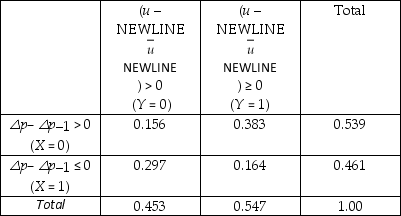The expectations augmented Phillips curve postulates
△p = π - f (u -  ),
),
where △p is the actual inflation rate,π is the expected inflation rate,and u is the unemployment rate,with "-" indicating equilibrium (the NAIRU - Non-Accelerating Inflation Rate of Unemployment).Under the assumption of static expectations (π = △p-1),i.e. ,that you expect this period's inflation rate to hold for the next period ("the sun shines today,it will shine tomorrow"),then the prediction is that inflation will accelerate if the unemployment rate is below its equilibrium level.The accompanying table below displays information on accelerating annual inflation and unemployment rate differences from the equilibrium rate (cyclical unemployment),where the latter is approximated by a five-year moving average.You think of this data as a population which you want to describe,rather than a sample from which you want to infer behavior of a larger population.The data is collected from United States quarterly data for the period 1964:1 to 1995:4.
Joint Distribution of Accelerating Inflation and Cyclical Unemployment,
1964:1-1995:4
 (a)Compute E(Y)and E(X),and interpret both numbers.
(a)Compute E(Y)and E(X),and interpret both numbers.
(b)Calculate E(Y  = 1)and E(Y
= 1)and E(Y  = 0).If there was independence between cyclical unemployment and acceleration in the inflation rate,what would you expect the relationship between the two expected values to be? Given that the two means are different,is this sufficient to assume that the two variables are independent?
= 0).If there was independence between cyclical unemployment and acceleration in the inflation rate,what would you expect the relationship between the two expected values to be? Given that the two means are different,is this sufficient to assume that the two variables are independent?
(c)What is the probability of inflation to increase if there is positive cyclical unemployment? Negative cyclical unemployment?
(d)You randomly select one of the 59 quarters when there was positive cyclical unemployment ((u -  )> 0).What is the probability there was decelerating inflation during that quarter?
)> 0).What is the probability there was decelerating inflation during that quarter?
Correct Answer:
Verified
View Answer
Unlock this answer now
Get Access to more Verified Answers free of charge
Q41: There are frequently situations where you have
Q43: Think of an example involving five possible
Q44: Calculate the following probabilities using the standard
Q47: A few years ago the news magazine
Q48: You are at a college of roughly
Q49: In considering the purchase of a certain
Q50: The accompanying table shows the joint distribution
Q51: What would the correlation coefficient be if
Q52: The height of male students at your
Q55: Two random variables are independently distributed if
Unlock this Answer For Free Now!
View this answer and more for free by performing one of the following actions

Scan the QR code to install the App and get 2 free unlocks

Unlock quizzes for free by uploading documents